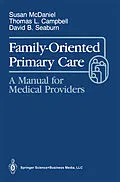FAMILY-ORIENTED PRIMARY CARE, 2nd Edition, offers practical guidance for the physician who would like to take greater advantage of this resource. The result is a readable guide, structured around step-by-step protocols that are vividly illustrated with case studies drawn from the author's extensive collaboration at the University of Rochester.
Klappentext
A family orientation in health care can provide a wider understanding of illness and a broader range of solutions than the classic biomedical model. This volume thus offers practical guidance for the physician who would like to take greater advantage of this resource. The result is a readable guide, structured around step-by-step protocols that are vividly illustrated with case studies drawn from the authors extensive experience at the University of Rochester School of Medicine.
Inhalt
The Biopsychosocial Assessment of the Family.- 1 Basic Premises of Family-Oriented Primary Care: Utilizing the Family as a Resource.- 2 How Families Affect Illness: Research on the Family's Impact on Health.- 3 Family Systems Concepts: Tools for Assessing the Family in Primary Care.- 4 Greasing the Wheels: Promoting a Working Alliance with Patient and Families.- 5 Convening the Family: How, When, and to What End?.- 6 Conducting a Family Conference: A Cornerstone for Family-Oriented Care.- Health Care of the Family in Transition.- 7 Working with Couples in Primary Care: The Backbone of the Family Treatment System.- 8 The Birth of a Family: A Family-Oriented Approach to Pregnancy Care.- 9 Supporting Parents: Family-Oriented Child Health Care.- 10 When Parents Get Stuck: Working with Parents on Child Behavior Problems.- 11 Balancing Alliances: Family-Oriented Care of Adolescents.- 12 Recognizing the Signs of Strain: Counseling Couples in Primary Care.- 13 Anticipating Loss: Health Care for the Elderly and Their Family Caregivers.- 14 Looking Death in the Eye: Death, Grieving, and Families.- A Family-Oriented Approach to Specific Medical Problems.- 15 The Developmental Challenges of Chronic Illness: Helping Patients and Families Cope.- 16 Integrating the Mind-Body Split: A Biopsychosocial Approach to Somatic Fixation.- 17 Mobilizing Resources: Treating Depression in Primary Care.- 18 When Drinking is Part of the Problem: A Family Approach to the Detection and Management of Alcohol Abuse.- 19 Protecting the Family: Child Abuse and Primary Care.- Implementing Family-Oriented Primary Care.- 20 Family-Oriented Primary Care in the Real World: Ethical and Practical Issues.- 21 Acute Hospital Care: Letting the Family In.- 22 Working Together: Collaboration and Referral to Family-Oriented and Mental Health Professionals.- 23 Managing Personal and Professional Boundaries: How to Make the Physician's Own Issues a Resource in Patient Care.- Indexes.
